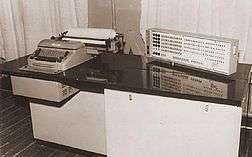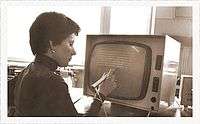MIR (computer)

The MIR series of early Soviet personal computers was developed from 1965 (MIR), 1968 (MIR-1) to 1969 (MIR-2) in a group headed by Victor Glushkov. MIR (МИР) stands for «Машина для Инженерных Расчётов» (Machine for Engineering Calculations) and means both "world" and "peace" in Russian. It was designed as a relatively small-scale computer for use in engineering and scientific applications. Among other innovations, it contained a hardware implementation of a high-level programming language capable of symbolic manipulations with fractions, polynomials, derivatives and integrals. Another innovative feature for that time was the user interface combining a keyboard with a monitor and light pen used for correcting texts and drawing on screen. It could be considered one of the first personal computers.

Technical specifications
Technical specifications for MIR-1:[1]
- memory unit: 4096 12-bit words of core memory (access time 2.5 microseconds, memory cycle time 16 microseconds)
- external storage: 8-track punched tape. Input device: paper tape reader FS-1501 (up to 1500 symbols/second). Output device: tape punch PL-80 (up to 80 characters per second)
- performance: 200-300 arithmetic operations per second on 5 digit numbers
- power consumption: 1.5 kW (using 380V three-phase electric power)
- weight: about 400 kg
References
- ↑ А. Савватеев. "Описание входного языка ЭВМ «Мир» и «Мир-1»" [Description of the input language of the computers "MIR" and "MIR-1"] (PDF) (in Russian).
See also
External links
- Description of Mir series of computers (in Russian)
- MIR-2